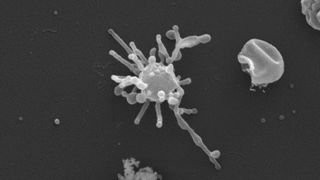Nicoletta Lanese writes:
Ancient microbes whose existence predates the rise of nucleus-carrying cells on Earth may hold the secrets to how such complex cells first came to be. Now, for the first time, scientists have grown a large enough quantity of these microbes in the lab to study their internal structure in detail, Science reported.

(Image credit: © Thiago Rodrigues-Oliveira, Univ. Wien)
Researchers grew an organism called Lokiarchaeum ossiferum, which belongs to a group of microbes known as Asgard archaea, according to a new report, published Wednesday (Dec. 21) in the journal Nature. Named after the abode of the gods in Norse mythology, Asgard archaea are thought by some scientists to be the closest evolutionary relatives of eukaryotes, cells that package their DNA in a protective bubble called a nucleus.
On the evolutionary tree of life, Asgards often appear as a “sister” of eukaryotes or as their direct ancestor, Jan Löwe, leader of the Bacterial Cytoskeleton and other Molecular Machines research group at the Medical Research Council (MRC) Laboratory of Molecular Biology in the U.K., wrote in a commentary about the new study. Asgards don’t carry nuclei themselves, but they do contain a suite of genes and proteins that were once thought to be unique to eukaryotes. Researchers have a variety of theories as to how Asgards may have gained primitive nuclei and thus birthed the first complex cells, which later gave rise to plants, animals and humans.
In 2020, a research group in Japan reported that, after 12 years of work, they’d successfully grown Asgards in the lab.
“It has taken six long years to obtain a stable and highly enriched culture, but now we can use this experience to perform many biochemical studies and to cultivate other Asgard archaea as well,” co-senior author Christa Schleper, leader of the archaea ecology and evolution lab at the University of Vienna, said in a statement.
Gathered from mud in a canal on the coast of Piran, Slovenia, the L. ossiferum specimens have funky tentacles that extend from the body of each cell; odd bumps and bulges appear along the length of each appendage. These “surface protrusions” may support the idea that, at some point in evolutionary history, an Asgard grabbed a passing bacterium using similar extensions of its membrane and sucked the bacterium into its cell body, and this led to the development of the nucleus, Löwe wrote. The protrusions support the idea that such an interaction could have occurred, he explained.
L. ossiferum also carries tiny, lollipop-like structures on its surface, which “look like they come from another planet,” Thijs Ettema, an environmental microbiologist at Wageningen University in the Netherlands who wasn’t involved in the work, told Science. The microbe also contains structural filaments that closely resemble those seen in the cytoskeleton, or supporting scaffold, of eukaryotic cells, Löwe wrote.
Some scientists think the new study strengthens the hypothesis that Asgards are eukaryotes’ direct ancestor, but not everyone is convinced. Read more in Science.
Full article at Live Science.
The following statement by researchers lacks a certain quality of scientific professionalism: “These ‘surface protrusions’ may support the idea that, at some point in evolutionary history, an Asgard grabbed a passing bacterium using similar extensions of its membrane and sucked the bacterium into its cell body, and this led to the development of the nucleus.” Can anybody pinpoint how this statement falls short of scientific expectations, beyond perhaps the elementary school level?